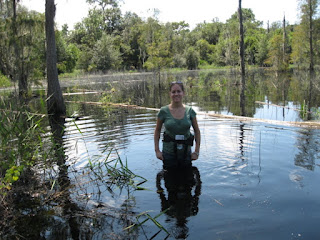Florida Ornithological Society Position Statement on Outdoor Cats
The Florida Ornithological Society (FOS) is deeply concerned about the threat that free-roaming domestic cats pose to Florida's native birds, mammals, and other imperiled wildlife. Domestic cats are non-native carnivores introduced to North America in the 1600s. Outdoor cats negatively impact both rare and common species and even people throughout Florida. Cats kept indoors are great pets and lead considerably healthier and longer lives than cats allowed to roam outdoors. Accordingly, FOS takes the position that all cats should be kept indoors because of the reasons listed below which are supported by numerous scientific studies.
FOS does not advocate the inhumane killing of cats by poisoning, shooting, or vigilante activities.
Threats to Bird Populations
Outdoor cats kill millions of Florida birds annually (Lepczyk et al. 2003). In one estimate, free-ranging domestic cats killed 1.3-4.0 billion birds annually in the U.S. (Loss et al. 2013). The killing of birds continues even when cats are well-fed by humans (Adamec 1976, Loyd et al. 2013), and fitting cats with bells or declawing them does not prevent them from killing birds or other wildlife (Nelson et al. 2005). Young birds are especially vulnerable to the threat of cats because they are usually learning to fly for a few days after leaving their nest.
Threats to Other Wildlife
Domestic cats have contributed to at least 63 animal extinctions and pose a major hazard to rare and threatened wildlife worldwide (Loss and Marra 2017). In addition to birds, cats regularly kill other native wildlife including lizards, amphibians, and mammals (Loss et al. 2013). One estimate suggests free-ranging domestic cats kill 6.3-22.3 billion mammals annually in the U.S. (Loss et al. 2013).
Threats to Cat Health
Cats in a healthy indoor environment live much longer than cats allowed to roam outdoors (Barrows 2004). Outdoor cats can become infected with feline leukemia virus, feline immunodeficiency virus, hookworms, roundworms, ringworm, rabies and many other diseases and parasites that indoor cats are much less likely to contract (Longcore et al. 2009). Hookworms, roundworms, ringworm and rabies are zoonotic (transmissible to people). Outdoor cats are also vulnerable to getting into fights with other cats, being run over by cars, and being killed by coyotes, raccoons, or dogs.
Threats to Human Health
Toxoplasmosis is spread by outdoor cats and can kill unborn human babies (Peyron et a. 2016), cause blindness, and lead to many other human illnesses and complications (Aguirre et al. 2019). Cats that are kept strictly indoors and fed only well-cooked meat do not become infected with Toxoplasma. Cats also are the leading vector of rabies among domestic animals in the U.S. (Blanton et al. 2007).
The Florida Ornithological Society is a statewide organization of bird watchers, professional biologists, and academic ornithologists. The group publishes scientific articles on Florida's wildlife, funds independent research on Florida wildlife, and supports the use of scientific information in development of public policy. For more information, visit www.fosbirds.org.
Literature cited Adamec, R.E. 1976. The interaction of hunger and preying in the domestic cat (Felis catus): an adaptive hierarchy. Behavioral Biology 18:263-272.
Aguirre, A.A., T. Longcore, M. Barbieri, H. Dabritz, D. Hill, P. Klein, C. Lepczyk, E. Lilly, R. McLeod, J. Milcarsky, C. Murphy, C. Su, E. VanWormer, R. Yolken, and G. Sizemore. 2019. The one health approach to toxoplasmosis: epidemiology, control, and prevention strategies. EcoHealth 16:378-390. https://doi.org/10.1007/s10393-019-01405-7
Barrows, P.L. 2004. Professional, ethical, and legal dilemmas of trap‐neuter‐release. Journal of the American Veterinary Medical Association 225:1365-1369.
Blanton, J.D., C.A. Hanlon, and C.E. Rupprecht. 2007. Rabies surveillance in the United States during 2006. Journal of the American Veterinary Medical Association 231:540-556.
Lepczyk, C.A., A.G. Mertig, and J. Liu. 2003. Landowners and cat predation across rural‐to‐urban landscapes. Biological Conservation 115:191-201.
Longcore, T., C. Rich, and L.M. Sullivan. 2009. Critical assessment of claims regarding management of feral cats by trap-neuter-return. Conservation Biology 23, 887-894.
Loss, S.R., T. Will, and P. Marra. 2013. The impact of free-ranging domestic cats on wildlife of the United States. Nature Communications 4:1396. doi: 10.1038/ncomms2380.
Loss, S.R., and P. Marra. 2017. Population impacts of free‐ranging domestic cats on mainland vertebrates. Frontiers in Ecology and the Environment 15(9):502-509.
Loyd, K.T., S.M. Hernandez, J.P. Carroll, K.J. Abernathy, G.J. Marshall. 2013. Quantifying free-roaming domestic cat predation using animal-borne video cameras. Biological Conservation 160:183-189.
Nelson, S.H., A.D. Evans and R.B. Bradbury. 2005. The efficacy of collar-mounted devices in reducing the rate of predation of wildlife by domestic cats. Applied Animal Behavior Science 94:273-285. https://www.sciencedirect.com/science/article/abs/pii/S0168159105000742
Peyron F., M. Wallon, F. Kieffer, and J. Garweg. 2016. Toxoplasmosis. In Remington and Klein's Infectious Diseases of the Fetus and Newborn Infant, 8th edition. C.B. Wilson, V. Nizet, Y.A. Maldonado, J.S. Remington, and J.O. Klein, editors. Elsevier Saunders; Philadelphia, PA.

